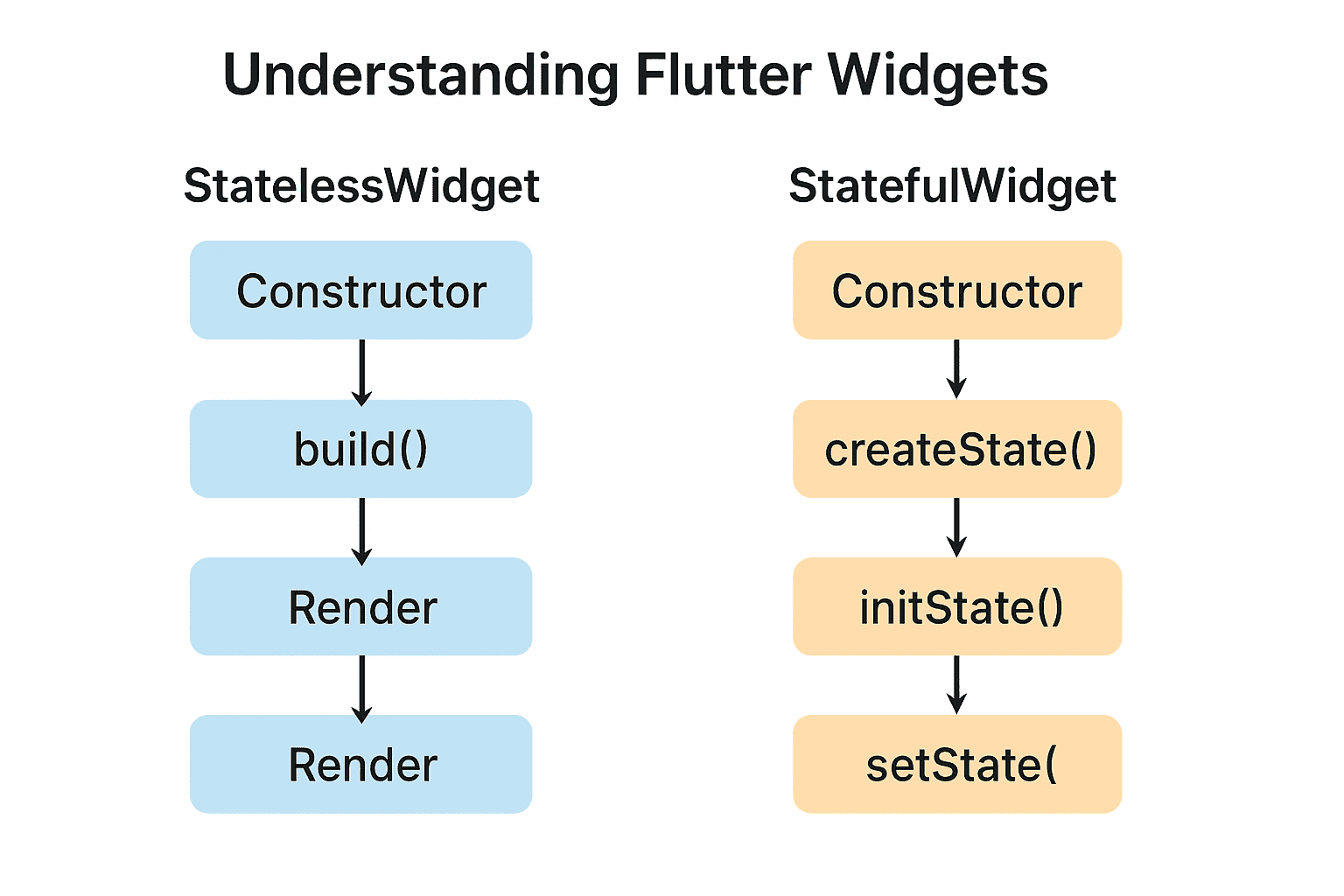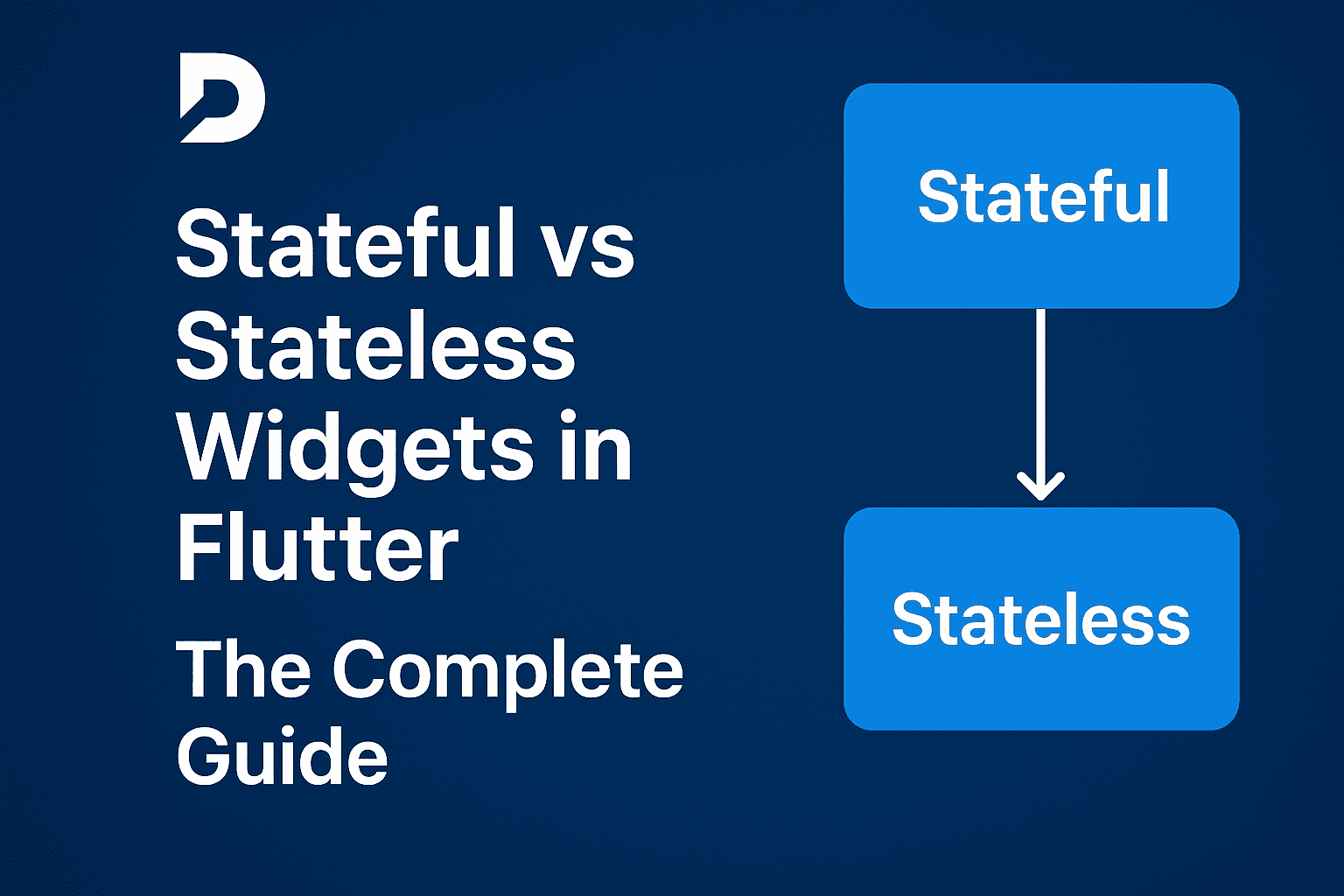Introduction
When building Flutter apps, understanding the difference between Stateful and Stateless widgets is fundamental to creating efficient, maintainable applications. These two widget types form the backbone of Flutter’s declarative UI system, and choosing the right one can dramatically impact your app’s performance and code quality. So we will be learning about Stateful vs Stateless Widgets in Flutter.
What you’ll learn in this guide:
- The core differences between Stateful and Stateless widgets
- When to use each type (with real-world examples)
- Performance implications and best practices
- Common pitfalls and how to avoid them
- Practical code examples you can use immediately
Understanding Flutter Widgets
Before diving into the differences, let’s establish what widgets are in Flutter. Widgets are the building blocks of every Flutter app—everything you see on screen is a widget. Text, buttons, layouts, animations, and even padding are all widgets.
Flutter uses a declarative approach: you describe what the UI should look like, and Flutter handles the rendering.

Stateless Widgets: The Immutable Foundation
Definition
A StatelessWidget is immutable—once created, it cannot change. It has no internal state and is rebuilt only when its parent widget tells it to rebuild with new data.
Basic Structure
class MyStatelessWidget extends StatelessWidget {
final String title; // Immutable property
// Constructor to receive data from parent
const MyStatelessWidget({Key? key, required this.title}) : super(key: key);
@override
Widget build(BuildContext context) {
// This method is called every time the widget needs to be rendered
return Text(
title,
style: TextStyle(fontSize: 24),
);
}
}
Real-World Example
class ProductCard extends StatelessWidget {
final String productName;
final double price;
final String imageUrl;
const ProductCard({
Key? key,
required this.productName,
required this.price,
required this.imageUrl,
}) : super(key: key);
@override
Widget build(BuildContext context) {
return Card(
child: Column(
children: [
Image.network(imageUrl),
Text(productName, style: Theme.of(context).textTheme.titleLarge),
Text('\$${price.toStringAsFixed(2)}'),
],
),
);
}
}
When to Use Stateless Widgets
- Static content: Logos, headings, descriptions
- Layout widgets: Containers, rows, columns that don’t change
- Display components: Product cards, profile pictures, icons
- Performance-critical sections: Lists with many identical items
Stateful Widgets: Dynamic and Interactive
Definition
A StatefulWidget can change over time. It maintains internal state that can be modified, and when that state changes, the widget automatically rebuilds to reflect the new state.
Basic Structure
// The widget class itself is still immutable
class MyStatefulWidget extends StatefulWidget {
const MyStatefulWidget({Key? key}) : super(key: key);
@override
State<MyStatefulWidget> createState() => _MyStatefulWidgetState();
}
// The state class holds mutable data
class _MyStatefulWidgetState extends State<MyStatefulWidget> {
int _counter = 0; // Mutable state variable
// Method to update state
void _incrementCounter() {
setState(() {
_counter++; // Modify state and trigger rebuild
});
}
@override
Widget build(BuildContext context) {
return Column(
children: [
Text('Counter: $_counter'),
ElevatedButton(
onPressed: _incrementCounter,
child: Text('Increment'),
),
],
);
}
}
Advanced Example with Proper Lifecycle Management
class UserProfileForm extends StatefulWidget {
const UserProfileForm({Key? key}) : super(key: key);
@override
State<UserProfileForm> createState() => _UserProfileFormState();
}
class _UserProfileFormState extends State<UserProfileForm> {
final _formKey = GlobalKey<FormState>();
final _nameController = TextEditingController();
final _emailController = TextEditingController();
bool _isLoading = false;
String? _errorMessage;
@override
void initState() {
super.initState();
// Initialize resources, set up listeners
_loadUserData();
}
@override
void dispose() {
// Clean up resources to prevent memory leaks
_nameController.dispose();
_emailController.dispose();
super.dispose();
}
Future<void> _loadUserData() async {
setState(() => _isLoading = true);
try {
// Simulate API call
await Future.delayed(Duration(seconds: 2));
_nameController.text = "John Doe";
_emailController.text = "john@example.com";
setState(() => _errorMessage = null);
} catch (e) {
setState(() => _errorMessage = "Failed to load user data");
} finally {
setState(() => _isLoading = false);
}
}
@override
Widget build(BuildContext context) {
if (_isLoading) {
return Center(child: CircularProgressIndicator());
}
return Form(
key: _formKey,
child: Column(
children: [
if (_errorMessage != null)
Text(_errorMessage!, style: TextStyle(color: Colors.red)),
TextFormField(
controller: _nameController,
decoration: InputDecoration(labelText: 'Name'),
validator: (value) => value?.isEmpty == true ? 'Required' : null,
),
TextFormField(
controller: _emailController,
decoration: InputDecoration(labelText: 'Email'),
validator: (value) => value?.contains('@') != true ? 'Invalid email' : null,
),
ElevatedButton(
onPressed: () {
if (_formKey.currentState?.validate() == true) {
// Handle form submission
}
},
child: Text('Save Profile'),
),
],
),
);
}
}
When to Use Stateful Widgets
- User interactions: Forms, buttons with dynamic behavior
- Data from APIs: Content that changes based on network requests
- Animations and timers: Components that update over time
- Input handling: Text fields, sliders, checkboxes
- Live updates: Chat messages, real-time data feeds
Detailed Comparison
| Aspect | Stateless Widget | Stateful Widget |
|---|---|---|
| Mutability | Immutable after creation | Can change internal state |
| Performance | Faster rendering | Slightly more overhead |
| Memory Usage | Lower | Higher (stores state) |
| Lifecycle Methods | Only build() | initState(), dispose(), etc. |
| Rebuild Triggers | Parent widget changes | Parent changes OR setState() called |
| Use Cases | Static content, layouts | Interactive elements, dynamic data |
| Testing | Easier to test | More complex testing scenarios |
| State Management | No internal state | Manages own state |
Real-World Application Examples
E-commerce App Architecture
Login Screen:
// Stateless components
- AppLogo (company logo)
- WelcomeText ("Welcome to our app")
- BackgroundImage
- PrivacyPolicyLink
// Stateful components
- LoginForm (email/password fields, validation states)
- LoginButton (loading state during authentication)
- ErrorDisplay (shows/hides error messages)
- RememberMeCheckbox (checked/unchecked state)
Product Listing Page:
// Stateless components - ProductCard (displays product info) - PriceTag (shows formatted price) - CategoryHeader (section titles) // Stateful components - SearchBar (user input, search suggestions) - FilterButtons (selected/unselected states) - FavoriteButton (liked/unliked states) - ShoppingCartIcon (item count badge)
Performance Impact Example
In a real-world test with a product catalog containing 100 items:
// Before: Using StatefulWidget for static product cards
class ProductCard extends StatefulWidget { /* ... */ }
// Result: 45-50 FPS on mid-range device
// After: Converting to StatelessWidget
class ProductCard extends StatelessWidget { /* ... */ }
// Result: 55-60 FPS on same device
// Improvement: ~20% better performance
Why the improvement? Stateless widgets have less overhead during Flutter’s widget tree traversal and rendering process.
Best Practices and Common Mistakes
Best Practices
- Start with Stateless: Always begin with a StatelessWidget and only convert to StatefulWidget when you need to manage state.
- Proper Resource Management:
class _MyWidgetState extends State<MyWidget> {
late Timer _timer;
@override
void initState() {
super.initState();
_timer = Timer.periodic(Duration(seconds: 1), _updateTime);
}
@override
void dispose() {
_timer.cancel(); // Prevent memory leaks
super.dispose();
}
}
- Keep Build Methods Pure:
// ❌ Bad: Side effects in build method
@override
Widget build(BuildContext context) {
someApiCall(); // Don't do this!
return Text('Hello');
}
// ✅ Good: Pure build method
@override
Widget build(BuildContext context) {
return Text('Hello');
}
- Lift State Up: When multiple widgets need to share state, move it to a common parent:
// Parent manages state for both children
class ParentWidget extends StatefulWidget {
@override
_ParentWidgetState createState() => _ParentWidgetState();
}
class _ParentWidgetState extends State<ParentWidget> {
String sharedData = "";
@override
Widget build(BuildContext context) {
return Column(
children: [
ChildA(data: sharedData, onChanged: (value) => setState(() => sharedData = value)),
ChildB(data: sharedData),
],
);
}
}
Common Mistakes to Avoid
- Overusing Stateful Widgets: Don’t use StatefulWidget for purely display purposes.
- Calling setState in build(): This creates infinite rebuild loops.
// Bad: Never do this
@override
Widget build(BuildContext context) {
setState(() {}); // Infinite loop!
return Text('Hello');
}
- Heavy Computations in State: Keep expensive operations out of the State class.
// Bad: Heavy computation in state
class _MyWidgetState extends State<MyWidget> {
List<ComplexData> processedData = [];
void _processData() {
// Expensive operation in UI thread
processedData = heavyComputation(rawData);
setState(() {});
}
}
// Good: Use compute() for heavy operations
class _MyWidgetState extends State<MyWidget> {
List<ComplexData> processedData = [];
Future<void> _processData() async {
final result = await compute(heavyComputation, rawData);
setState(() => processedData = result);
}
}
Performance Optimization Tips
- Use const constructors whenever possible:
class MyWidget extends StatelessWidget {
const MyWidget({Key? key}) : super(key: key); // const constructor
@override
Widget build(BuildContext context) {
return const Text('Hello'); // const widget
}
}
- Minimize setState() calls: Batch state changes when possible.
- Use ListView.builder for long lists instead of creating all widgets at once.
- Consider AutomaticKeepAliveClientMixin for expensive widgets that shouldn’t be rebuilt frequently.
Frequently Asked Questions
Q: Can I convert a StatefulWidget to StatelessWidget later? A: Yes! If you move the state management to a parent widget or external state manager (like Provider, Bloc, etc.), you can convert it to StatelessWidget.
Q: Do StatefulWidgets use more memory? A: Yes, slightly more because they maintain a State object, but the difference is usually negligible unless you have thousands of them.
Q: When should I use external state management instead of StatefulWidget? A: When state needs to be shared across multiple screens, persisted between app sessions, or when your state logic becomes complex.
Q: Can a StatelessWidget have final variables that change? A: The variables themselves can’t change, but if you pass a new instance with different values, the widget will rebuild with the new data.
Q: Is it expensive to convert between StatefulWidget and StatelessWidget? A: Flutter handles this efficiently, but frequent conversions in hot reload during development might slow things down slightly.
Next Steps
Now that you understand the fundamentals:
- Practice: Build a simple counter app using both widget types
- Experiment: Try converting some of your existing StatefulWidgets to StatelessWidgets
- Learn State Management: Explore Provider, Bloc, or Riverpod for complex state scenarios
- Performance: Use Flutter DevTools to profile your app’s performance
Additional Resources
- Official Flutter Widget Catalog
- Flutter Performance Best Practices
- State Management Documentation
- Flutter Widget Inspector
For more content Visit Deadloq. Thank You!!
